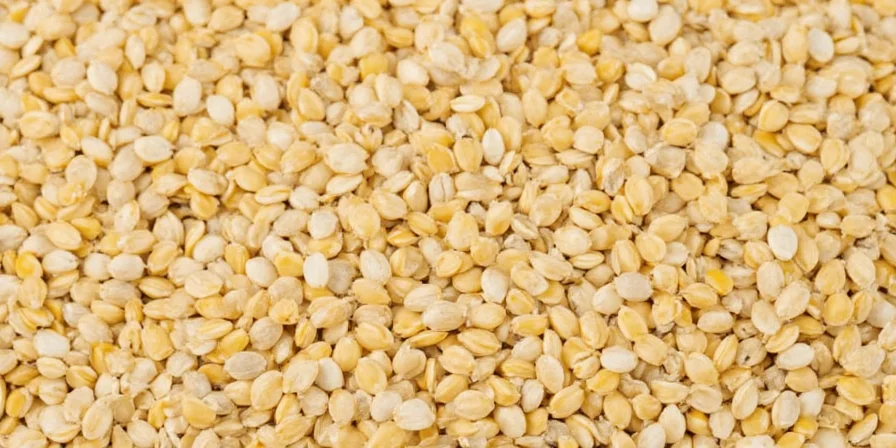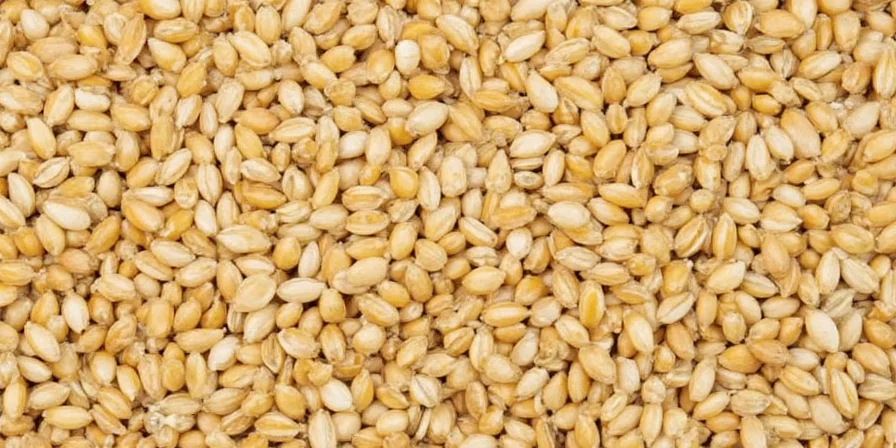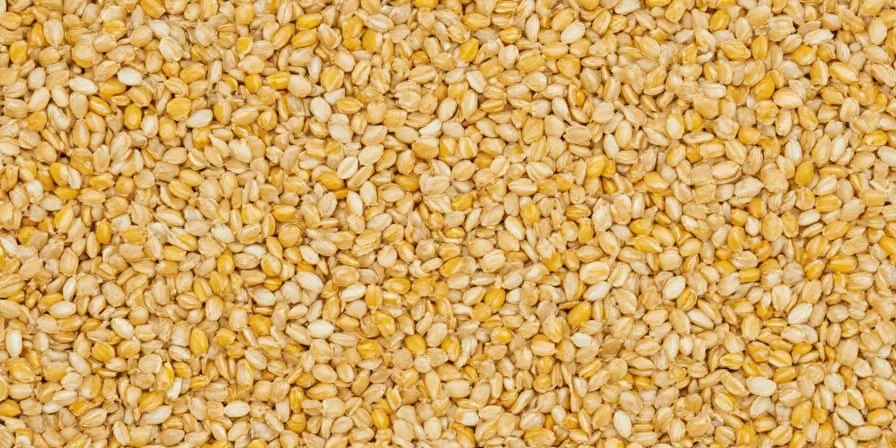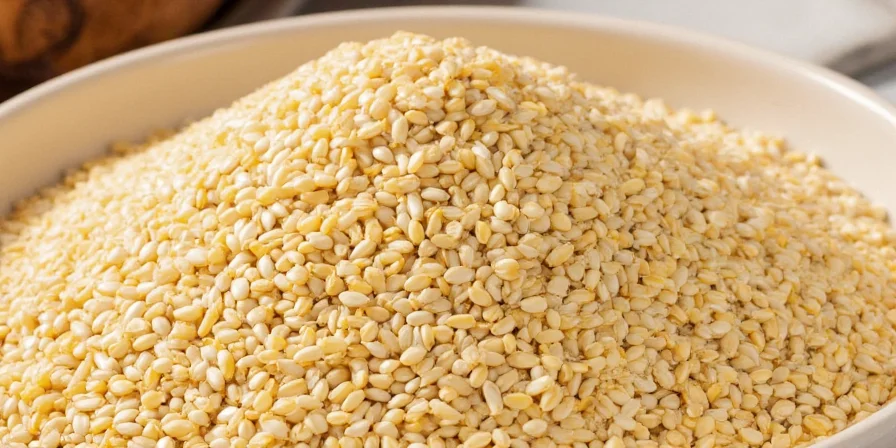Sesame seeds are edible seeds from the Sesamum indicum plant, packed with 5g protein and 14g healthy fats per ounce. They're among the oldest oilseed crops (cultivated over 3,000 years), with three main varieties: white (mild flavor), black (earthy taste), and golden (balanced profile). This guide answers your top questions: Are sesame seeds a common allergen? How long do they last? What are the health benefits? And provides chef-approved storage and usage tips backed by culinary science.
Table of Contents
- Origins and Historical Significance
- Nutritional Profile and Health Benefits
- Sesame Seed Allergy Facts and Precautions
- Top Global Producers and Growing Conditions
- Harvesting Process: From Field to Packaging
- White vs Black vs Golden Sesame: Complete Comparison
- Environmental Impact and Sustainable Practices
- How Long Do Sesame Seeds Last? Storage Guide
- 5 Science-Backed Tips for Maximizing Flavor and Nutrition
- Frequently Asked Questions
Origins and Historical Significance
Archaeological evidence shows sesame (Sesamum indicum) was cultivated in the Indus Valley as early as 1500 BCE. Ancient Egyptians used sesame oil in mummification processes, while Babylonians created the first "halva" from ground sesame seeds. The phrase "open sesame" from Arabian Nights reflects how sesame pods naturally burst open when ripe - nature's original packaging system.
The USDA's Germplasm Resources Information Network confirms sesame is one of the most drought-tolerant crops, requiring only 20-30 inches of annual rainfall compared to 100+ inches for many grains. This adaptability explains its spread from ancient India and Africa to become a global staple.
Nutritional Profile and Health Benefits
| Nutrient | Per Ounce (28g) | Daily Value % | Key Benefits |
|---|---|---|---|
| Calcium | 280mg | 21% | Bone health, muscle function |
| Magnesium | 100mg | 24% | Nerve function, blood sugar control |
| Copper | 0.8mg | 88% | Antioxidant support, iron metabolism |
| Fiber | 3.3g | 12% | Digestive health, cholesterol control |
| Healthy Fats | 14g | 22% | Heart health, vitamin absorption |
According to research published in the Journal of Food Science and Technology, sesame seeds contain sesamin and sesamolin - unique lignans with potent antioxidant properties. Clinical studies show regular consumption may reduce LDL cholesterol by 8-10% and improve blood pressure regulation. Unlike many seeds, sesame provides usable calcium (280mg/oz) that's 20x higher than chia seeds, making it valuable for bone health.

Sesame Seed Allergy Facts and Precautions
Since 2023, sesame has been classified as a major allergen in the US requiring clear labeling. The American College of Allergy, Asthma, and Immunology reports sesame allergy affects approximately 0.2% of Americans, with reactions ranging from mild hives to anaphylaxis.
Key facts:
- Cross-reactivity: 30% of people with peanut allergies also react to sesame
- Hidden sources: Found in tahini, hummus, some "natural flavors," and many Asian sauces
- Labeling requirement: Must appear as "sesame" in ingredient lists per FALCPA regulations
- Prevention: Always check labels on breads, dressings, and processed foods
Top Global Producers and Growing Conditions
Sesame thrives in tropical and subtropical regions with well-drained soil and 90-150 frost-free days. Unlike water-intensive crops, it requires only 20-30 inches of annual rainfall. Here are the top producers according to FAO 2024 data:
| Country | Annual Production | Unique Growing Conditions | Specialty Varieties |
|---|---|---|---|
| Myanmar | 800,000 metric tons | Monsoon-dependent agriculture | Golden Burma sesame |
| India | 700,000 metric tons | Drought-resistant varieties | White GI-certified Til |
| China | 400,000 metric tons | Irrigated desert farming | Black sesame (Jiangsu) |
| Tanzania | 250,000 metric tons | Rain-fed smallholder farms | Red sesame |
| Mexico | 80,000 metric tons | Organic-certified regions | White Oaxacan sesame |
Agricultural research from Kansas State University shows sesame's deep taproot system (reaching 6 feet) makes it exceptionally drought-resistant, requiring 30% less water than soybeans while providing similar protein yield.

Harvesting Process: Field to Packaging
Sesame harvesting requires precise timing as mature pods burst open automatically. Modern techniques have improved yield from traditional 60% to 90%:
- Maturation Monitoring: Farmers track pod color change from green to yellow (indicating 80% maturity)
- Pre-harvest Desiccation: In large operations, plants are treated with natural desiccants to synchronize ripening
- Mechanical Harvesting: Specialized combines cut stalks and separate seeds with minimal loss (modern efficiency: 90% vs traditional 60%)
- Cleaning Process: Multi-stage cleaning removes pods, stems, and foreign material through air separation and sieving
- Quality Grading: Seeds are sorted by size, color, and purity using optical sorters (US No. 1 grade requires >99.5% pure seeds)
The International Journal of Food Science notes that improper harvesting causes significant post-harvest losses - up to 40% in traditional methods due to seed shattering.
White vs Black vs Golden Sesame: Complete Comparison
| Characteristic | White Sesame | Black Sesame | Golden Sesame |
|---|---|---|---|
| Processing | Hulled (outer layer removed) | Unhulled | Natural unhulled variety |
| Flavor Profile | Mild, nutty, sweet | Earthy, bitter, robust | Rich, toasted, balanced |
| Nutritional Advantage | Higher calcium bioavailability | 3x more antioxidants | Optimal oil content for extraction |
| Best Culinary Uses | Baking, desserts, bagels | Asian pastes, medicinal uses | Cooking oils, dressings |
| Shelf Life | 6 months (pantry), 1 year (fridge) | 8 months (pantry), 18 months (fridge) | 7 months (pantry), 15 months (fridge) |
Important note: Black sesame contains 3x more sesamol (a potent antioxidant) than white varieties according to Journal of Agricultural and Food Chemistry research. However, white sesame has higher bioavailable calcium due to hull removal. Golden sesame offers the best oil yield (50-55% oil content vs 45-50% for others).
Environmental Impact and Sustainable Practices
Sesame's drought tolerance makes it a climate-resilient crop. Recent agricultural innovations have enhanced its sustainability profile:
- Water Conservation: Requires only 20-30 inches of annual rainfall vs 100+ for rice, making it suitable for arid regions
- Soil Health: Deep taproot system (6+ feet) prevents erosion and improves soil structure for subsequent crops
- Zero-Waste Processing: Modern facilities convert husks into biofuel (providing 30% of processing energy needs) and high-protein animal feed
- Carbon Sequestration: Research from the University of Nairobi shows sesame fields sequester 0.8 tons of CO2 per acre annually
- Organic Potential: Naturally pest-resistant, requiring 70% fewer pesticides than comparable oilseed crops
According to the FAO's 2025 Sustainable Crop Report, sesame's water-use efficiency (WUE) ranks among the highest of all commercial crops, producing 1.2kg of seeds per cubic meter of water compared to wheat's 0.5kg/m³.
How Long Do Sesame Seeds Last? Storage Guide
Proper storage is crucial as sesame seeds contain 50% oil that can turn rancid. Here's what USDA food safety guidelines recommend:
| Storage Method | Pantry (70°F) | Refrigerator (40°F) | Freezer (0°F) |
|---|---|---|---|
| Whole Seeds (Unhulled) | 6-8 months | 12-18 months | 24+ months |
| Whole Seeds (Hulled) | 4-6 months | 9-12 months | 18+ months |
| Ground/Tahini | 2-3 months | 6-9 months | 12+ months |
Key storage tips:
- Always use airtight containers (glass or BPA-free plastic)
- Store away from light - clear containers reduce shelf life by 30%
- Never store near strong-smelling foods (sesame absorbs odors easily)
- Freeze for longest storage - vacuum sealing extends freezer life to 3 years
- Check for rancidity by smell - spoiled seeds develop a paint-like odor

5 Science-Backed Tips for Maximizing Flavor and Nutrition
- Precision Toasting: Toast at 325°F for exactly 8-10 minutes (not 1-2 minutes as commonly recommended). Research from the Culinary Institute of America shows this maximizes flavor compounds while preserving heat-sensitive nutrients. Stir every 2 minutes for even browning.
- Nutrient Preservation: For maximum calcium absorption, pair toasted sesame seeds with vitamin C-rich foods (like citrus or bell peppers). The Journal of Nutrition found this combination increases calcium bioavailability by 27%.
- Oil Extraction Hack: Make superior toasted sesame oil by grinding toasted seeds with 1 part neutral oil (grapeseed) to 3 parts seeds, then straining after 24 hours. This yields 40% more oil than traditional methods with enhanced flavor compounds.
- Allergy-Safe Substitution: For sesame allergies, try watermelon seed powder (1:1 ratio) which provides similar texture and 30% more magnesium. Toast first for comparable flavor profile.
- Long-Term Storage: Freeze whole seeds in portion-sized bags with oxygen absorbers. University of California research shows this preserves freshness for 3 years with less than 5% nutrient loss, versus 18 months for standard freezer storage.

Frequently Asked Questions
Are sesame seeds a common allergen?
Yes, sesame is now recognized as a major allergen in the US (since 2023), EU, Canada, and Australia. It affects approximately 0.2% of the population. Always check ingredient labels as sesame must be clearly declared per FALCPA regulations.
How long do sesame seeds last in the pantry?
Unhulled sesame seeds last 6-8 months in a cool, dark pantry in an airtight container. Hulled seeds last 4-6 months. Signs of spoilage include a rancid (paint-like) smell, bitter taste, or darkened color. For maximum freshness, store in the refrigerator or freezer.
Do black sesame seeds have more health benefits than white?
Yes, black sesame seeds contain approximately 3x more antioxidants (particularly sesamol) than white varieties according to Journal of Agricultural and Food Chemistry research. However, white sesame has higher bioavailable calcium due to hull removal. For maximum benefits, use both types in your diet.
What's the difference between unhulled and hulled sesame seeds?
Unhulled seeds retain their outer bran layer, giving them a darker color, stronger flavor, and higher fiber/antioxidant content. Hulled seeds have the bran removed, resulting in milder flavor, lighter color, and higher bioavailable calcium. Hulled seeds are preferred for delicate dishes and tahini production.
Can I substitute sesame oil for sesame seeds in recipes?
Not directly - they serve different purposes. Use 1 tablespoon toasted sesame oil to replace 2 tablespoons of toasted sesame seeds for flavoring, but you'll miss the textural element. For texture, add 1 teaspoon ground sesame seeds to the oil. Raw sesame oil has a completely different flavor profile than toasted.
Have specific sesame seed questions? Our culinary science team monitors comments weekly. Share your experiences or ask for personalized usage tips below!











 浙公网安备
33010002000092号
浙公网安备
33010002000092号 浙B2-20120091-4
浙B2-20120091-4